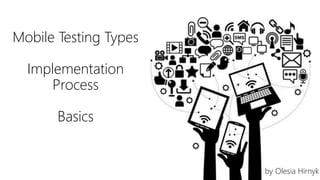Mobile Testing Types and Basic Process
- 1. Mobile Testing Types Implementation Process Basics by Olesia Hirnyk
- 2. Mobile Application Implementation Phases Analyze Design Develop Accept Feedback Implementation Test
- 3. Market Portfolio Target Audience User Scenarios User Experience Devices 1. Analyze
- 4. 2. Design UI design approach UX scenarios identification
- 5. Mobile Development Mobile Testing 3. Implement
- 6. Does it meat Client Expectations? 4. Accept/Feedback
- 7. Testing Mobile Testing Mobile Testing Usability Testing Functional Testing User Interface Testing Performance Testing Memory Leakage Testing Interrupt Testing Laboratory Testing Installation Testing Localization Testing Certification Testing Automation Testing Cross Platform Testing
- 8. Mobile Usability Testing Design Recognition Feedback Simplicity Common Sense
- 9. Mobile Functional Testing Meets business requirements does what it should do
- 10. Mobile User Interface Testing Matches designed UI Meets HIGs (Human Interface Guidelines)
- 11. Mobile Performance Testing Time to: Run React Response Load
- 12. Mobile Memory Leakage Testing How application behaves in case of memory leak 1. While installing 2. In Action
- 13. Mobile Interrupt Testing Incoming and Outgoing SMS/MMS Incoming and Outgoing calls Incoming Notifications Battery Removal Cable Insertion and Removal Network outage and recovery Media Player on/off Device Power cycle
- 14. Mobile Laboratory Testing Traffic dependency testing Simulating the complete wireless network Glitches when a mobile application uses voice and/or data connection to perform some functions GPS dependency
- 15. Mobile Installation Testing Install Update Remove Restore
- 16. Mobile Localization Testing Translations Characters Formatting
- 17. Mobile Certification Testing Is application created according guidelines set by different mobile platforms?
- 18. Mobile Cross Platform Testing Are you sure it will run under other platforms?
- 19. Mobile Automation Testing Covers different platforms Saves time and money for long term projects




















